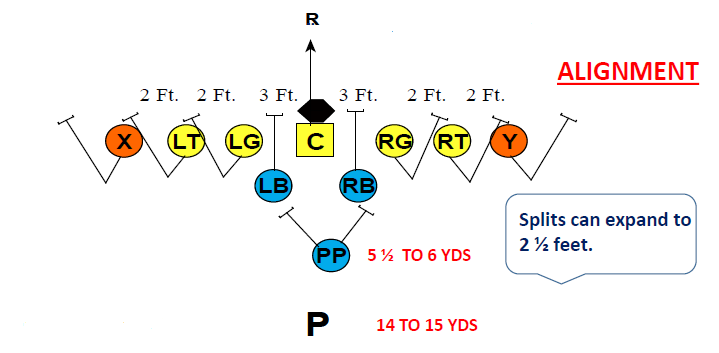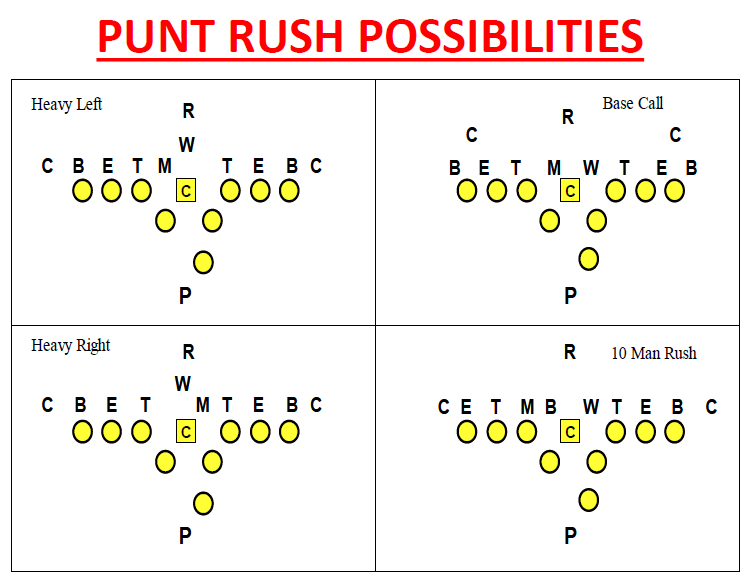Key points
• Put your best players on the punt team and spend and spend the necessary practice time practicing.
The punt.
• Don’t consider “Punt practice time” an “after practice” Activity.

• Center should strive to snap the ball back in In 7 to 9 tenths of a second
• Punter should be able to the ball off within 1.1 to 1.3 seconds
• The ball should be punted in 2.0 to 2.2 seconds
Whenever the Punter is standing in his own end zone, the Protector can make a “tight” call. The “tight” call should be predicated upon the alignment of the return team. However, when the ball is inside the 5 yard line a “tight” call is always made. The “tight” call will pull the alignment down into a tighter formation.
The changes include:
• The linemen cut do splits to six inches (except the guards will leave a one foot split
• The Gunners move down next to the tackles taking a six inch split.
• The Wings move to the Center/Guard gap
Here is a diagram of the Bomb Squad’s Tight Punt Alignment:

The snapper and punter are always important. but when in a tight punt situation, the margin of error becomes very small. The punter must catch the ball. If he does drop it: he msut fall on the ball and the team will give up the safety (two points). The punter must avoid giving up the touchdown (six points). Also, practice with your punters on how to take an Intentional safety. Do not just talk to your punter about these situations–coach them Talk football with then and then drill the situations on the practice field. Then, when the situation arises game night, you have a foundation to go over and remind therm of the process.
CENTER– Most important thing about the punt is the center’s snap. It must be perfect 0.7 seconds!
ASSIGNMENTS: Quick step. Retain wide base after the snap.
COVERAGE: You are usually not blocked off the line. Go to the ball. If first man to the Returner attack with a high tackle, force the returner to commit to a side.
GUARDS
STANCE: Two point stance with the outside foot slightly back. Hands on hips. Lined up on the heels of the center.
ASSIGNMENTS: Block first man outside you. Let the rusher go if he releases inside of you. The up back will block him. If there are two men in your gap block the man that is closets man going through the gap. Try to get a hand inside rusher after your bucket step.
COVERAGE: Run to the ball. Keep the returner on your inside shoulder.
TACKLES
STANCE: Two point stance with the outside foot slightly back. Hands on hips. Lined up on the heels of the center.
ASSIGNMENT: Block first man outside you. Let the rusher go if he releases inside of you. The guard will block him. If there are two men in your gap block the first man going through the gap. Try to a hand on the inside rusher after your bucket step.
COVERAGE: Run to the ball. Keep the returner on your inside shoulder.
ENDS:
STANCE: Two point stance with the outside foot slightly back. Hands on hips. Lined up on the heels of the tackle.
ASSIGNMENT: Block first man outside you. Let the rusher go if he releases inside of you. The guard will block him. If there are two men in your gap block the first man going through the gap. Try to a hand on the inside rusher after your bucket step.
COVERAGE: Run to the ball. You have contain/force on run. You are the widest man.
UPBACKS:
STANCE: Two point stance with feet balance. Hands on hips
ASSIGNMENTS: Block from the nose of the center to the nose of the guard. If two men are in the gap, stop the first cut the second
COVERAGE: Run the ball. Keep the ball on your inside shoulder.
PERSONAL PROTECTOR:
ASSIGNMENT: Count the defenders. Ask the punter if he is ready. Block the most dangerous rusher. Know were the overload is.
Never step back to block the outcome will not be good
COVERAGE: Release downfield. You are the safety. Be aware of the sideline return and the reverses. Make sure you alert the team of the ball is at.
PUNTER:
ASSIGNMENTS: Let the PP know when you are ready. Always call the direction of the punt. Get the punt off in 2.0 seconds are less { 1.3 seconds after receiving the snap } Get the distance and height.
COVERAGE: Safety man. Front up the ball at 15 yards.

About the Author of this post:
Jerry Campbell has over 30 years of high school and college coaching experience. He has experience as a head coach, offensive coordinator, and various position coaches. He has written numerous football coaching articles in various publications, is the author of over 30 books on coaching football, and has produced 12 coaching video series. Additionally, he is a nationally sought after speaker on the coaching clinic circuit.